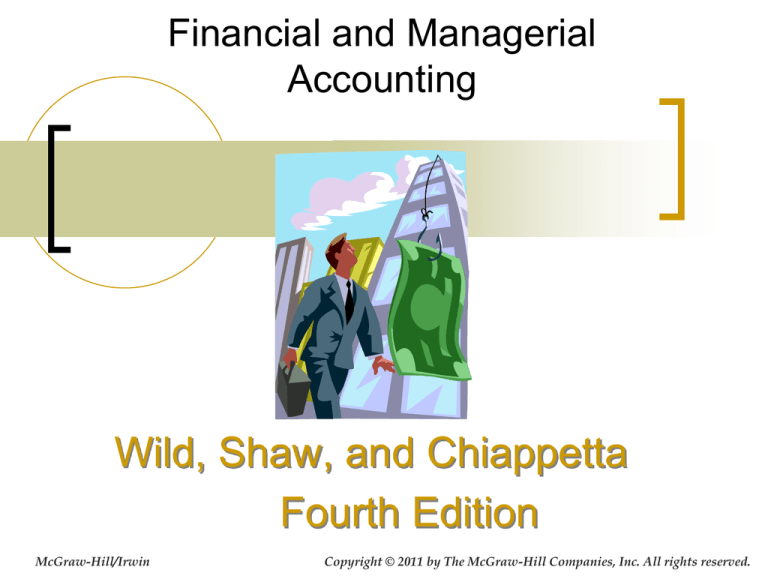
Financial and Managerial
Accounting
Wild, Shaw, and Chiappetta
Fourth Edition
McGraw-Hill/Irwin
Copyright © 2011 by The McGraw-Hill Companies, Inc. All rights reserved.
Chapter 17
Activity-Based Costing and
Analysis
Conceptual Learning Objectives
C1: Distinguish between the plantwide
overhead rate method, the departmental
overhead rate method, and activity-based
costing method.
C2: Explain cost flows for activity-based
costing.
C3: Describe the four types of activities that
cause overhead costs.
17-3
Analytical Learning Objectives
A1: Identify and assess advantages and
disadvantages of the plantwide overhead
rate and departmental overhead rate
methods.
A2: Identify and assess advantages and
disadvantages of activity-based costing.
17-4
Procedural Learning Objectives
P1: Allocate overhead costs to products
using the plantwide overhead rate
method.
P2: Allocate overhead costs to products
using departmental overhead rate
method.
P3: Allocate overhead costs to products
using activity-based costing.
17-5
C1
Assigning Overhead Costs
Indirect
Materials
Direct
Indirect
Factory Allocate
Overhead
Labor
Direct
Goods in
Process
Finished
Goods
Cost of
Goods
Sold
17-6
C1
Assigning Overhead Costs
Overhead can be assigned to production in
one of three ways:
Single plantwide rate
Departmental
overhead
rates
Activity-based
costing
17-7
P1
Plant Wide Overhead Rate Method
Indirect
Costs
Overhead Cost
Cost
Allocation
Base
Single Plant-Wide
Overhead Rate
Cost
Objects
Product 1 Product 2
Product 3
17-8
P1
Plant Wide Overhead Rate Method
Illustration
Exhibit 17.3 KartCo's Budgeted Direct Hours
Direct
Total
Number
Labor
Direct Labor
of units
Hours
Hours
Standard go-kart
5,000 X
15 =
75,000
Custom go-kart
1,000 X
25 =
25,000
Total
100,000
Kartco's Budgeted Overhead Costs
Indirect Labor costs……………………………………………………………
$4,000,000
Factory Utilities…………………………………………………………………
800,000
Total Overhead Costs…………………………………………………………
$4,800,000
17-9
P1
Plant Wide Overhead Rate
Method Illustration
Plantwide
Total budgeted overhead costs
overhead =
Total budgeted DLH
rate
17-10
P1
Plant Wide Overhead Rate
Method Illustration
Plantwide
overhead =
rate
=
$4,800,000
100,000 DLH
$48/DLH
17-11
P1
Plant Wide Overhead Rate
Method Illustration
Allocation of overhead cost to products
Standard go-kart
Custom go-kart
Overhead
Rate Per
DLH
$48 X
$48 X
Allocated
Per
DLH
Unit
15 = $ 720
25 = $ 1,200
Total product cost per unit
Standard go-kart
Custom go-kart
Direct
Materials
$
400
600
Direct
Labor
$
350
500
Factory
Overhead
$ 720
1,200
Total
Cost
Per Unit
$ 1,470
2,300
17-12
A1
Plantwide Overhead Rate Method
Advantages and Disadvantages
Advantages
Information is
readily available
Easy to implement
Often sufficient to
meet external
financial reporting
needs
Disadvantages
Overhead costs
may not bear any
relationship with
direct labor hours
All products may
not use overhead
costs in the same
proportion
17-13
C1
Departmental Overhead Rate
Method
Overhead Cost
First
Stage
Second
Stage
Department
A
Department A
Overhead Rate
Product 1
Department
B
Department B
Overhead Rate
Product 2
Product 3
Indirect
Costs
Cost
Objects
Allocation
Base
Cost
Objects
17-14
P2
Departmental Overhead Rate
Method: First Stage
Overhead Cost
$4,800,000
First
Stage
Machining Dept.
$4,200,000
Assembly Dept.
$600,000
17-15
P2
Departmental Overhead Rate
Method: Second Stage
Second
Stage
Department A
Overhead Rate
Product 1
Product 2
Department B
Overhead Rate
Product 3
17-16
P2
Departmental Overhead Rate
Method: Second Stage
Exhibit 17.6 Allocation Information for Machinery and Assembly Departments
Machining Department
Assembly Department
Number
of
Hours per Total
Hours per
Units
Unit
Hours
Unit Total Hours
Standard go-kart
Custom go-kart
Totals
5,000 10 MH
1,000 20 MH
50,000 MH
20,000 MH
70,000 MH
5 DLH
5 DLH
25,000 DLH
5,000 DLH
30,000 DLH
17-17
P2
Departmental Overhead Rate
Method: Second Stage
Departmental
Overhead =
Rate
Total departmental overhead costs
Total unit number in departmental
allocation base
17-18
P2
Departmental Overhead Rate
Method: Second Stage
Machining
Department =
Overhead
Rate
Assembly
Department =
Overhead
Rate
$4,200,000
= $60/MH
70,000 MH
$600,000
=
$20/DLH
30,000 DLH
17-19
P2
Departmental Overhead Rate
Method: Second Stage
Exhibit 17.7 Overhead Allocation Using Departmental Overhead Rates
Standard go-kart
Machining Dept.
Assembly Dept.
Totals
Departmental
Hours per
Overhead
Overhead Rate
Unit
Allocated
$60 per MH
10 MH per unit
$600
$20 per DLH 5 DLH per unit
100
$700
Custom go-kart
Hours per
Unit
20 MH per Unit
5 DLH per unit
Overhead
Allocated
$ 1,200.00
$
100.00
$ 1,300.00
Total cost per unit
Standard Go-Kart
Custom Go-Kart
Direct
Materials
$
400
600
$
Direct
Labor
350
500
Factory
Overhead
$
700
1,300
$
Total
Cost
1,450
2,400
17-20
A1
Advantages and Disadvantages of
Departmental Overhead Rate Method
Advantages
Disadvantages
•More accurate overhead
allocations
•Can distort product
costs
•More refined than the
plantwide overhead rate
method
•Assumes that products
are similar in volume,
complexity, batch size
•Assumes that
departmental overhead
costs are proportional to
the allocation base
17-21
C2
Cost Flows Under Activity-Based
Costing Method
Overhead Cost
First
Stage
Second
Stage
Indirect Costs
Activity
Cost
Pool X
Activity
Cost
Pool Y
Activity
Cost
Pool Z
Activity Overhead
rate
Activity Overhead
rate
Activity Overhead
rate
Product 1
Product 2
Product 3
Cost Objects
Cost Allocation
Base
Cost Objects
17-22
P3
Applying Activity-Based
Costing
4 steps:
1.
Identify activities and the costs they cause.
2.
Group similar activities into activity pools.
3.
Determine an activity rate for each activity
cost pool.
4.
Allocate overhead costs to products using
those activity rates.
17-23
C3
Four types of activities that
cause overhead costs
Unit level
Batch level
Product level
Facility level
17-24
C3
Levels of activities
Unit level
Unit level activities are performed
on each product unit; for
example, providing electricity to
power machinery in the
machining department is needed
to produce each unit of product.
17-25
C3
Levels of Activities
Batch level
Batch level activities are performed
only on each batch or group of
units.
17-26
C3
Levels of Activities
Product level
Product level activities are
performed on each product line
and are not affected by either
numbers of units or batches.
17-27
C3
Facility Level Activities
Facility level
Facility level activities are
performed to sustain facility
capacity as a whole and are not
caused by any specific product.
17-28
P3
Step Two: Trace Overhead
Costs to Cost Pools
Overhead Cost
Activity
Cost
Pool X
Activity
Cost
Pool Y
Activity
Cost
Pool Z
17-29
P3
Step Two: Trace Overhead Costs
to Cost Pools
Exhibit 17.10 Kartco Overhead Cost Details
Indirect
Activity
Labor
Replacing Tools
$700,000
Machine Repair
$ 1,300,000
Factory Maintenance $
800,000
Engineer Salaries
$ 1,200,000
Assembly Line Power
Heating and Lighting
Totals
$4,000,000
Factory
Utilities
$600,000
200,000
$800,000
Total
Overhead
$700,000
1,300,000
800,000
1,200,000
600,000
200,000
$4,800,000
17-30
P3
Step Two: Assigning Overhead to
Activity Cost Pools
Exhibit 17.11 Assigning Overhead Costs to Activity Pools
Activity Pools
Activity Cost Pooled Cost Activity Driver
Craftsmanship
30,000 direct labor hours
Assembly line power
$600,000
$600,000
Set-up
200 batches
Replacing tools
700,000
Machine repair
1,300,000
2,000,000
Design modification
10 designs
Engineer salaries
1,200,000
1,200,000
Plant services
Factory maintenance
800,000
20,000 square feet
Heating and lighting
200,000
1,000,000
17-31
Total overhead cost
$4,800,000
P3
Step Three: Determine
Activity Rate
Activity
Cost
Pool X
Activity
Cost
Pool Y
Activity Overhead
rate
Activity Overhead
rate
Activity
Cost
Pool Z
Activity Overhead
rate
Step 3 is to compute the activity rates
used to assign overhead costs to final
cost objects such as products.
17-32
P3
Step Three: Determine
Activity Rate
Proper determination of activity
rates depends on:
Proper
identification
of the factor
that drives
the cost
and
Proper
measures of
activities
17-33
P3
Step Three: Determine
Activity Rate
Activity
rate
=
Total cost in activity pool
Measure of the activity
For example:
Set-up cost pool activity rate = $2,000,000 / 200 batches
= $10,000 per batch
Craftsmanship cost pool activity rate = $600,000/30,000 DLH
= $20 per DLH
17-34
Step Three: Determine
Activity Rate
P3
Exhibit 17.12 Activity Rates for KartCo.
Overhead Costs
Activity Cost
Assigned to
Pools
Pool
Craftsmanship
Set-up
$600,000
2,000,000
Design
modification
1,200,000
Plant services
1,000,000
Activity
Measure
Chosen
Number of
Activities
Activity Rate
DLH
30,000 DLH
$20 per DLH
Batches
200 batches $10,000 per batch
Number of
design
10 designs $120,000 per design
modifications
Square feet 20,000 sq. ft.
$50 per sq. ft.
17-35
P3
Step Four: Assign Overhead
Costs to Cost Objects
Activity Overhead
rate
Product 1
Activity Overhead
rate
Activity Overhead
rate
Product 2
Product 3
Step 4 is to assign overhead costs in
each activity cost pool to final cost
objects using activity rates.
17-36
P3
Step Four: Assign Overhead
Costs to Cost Objects
To illustrate, the overhead costs in
the craftsmanship pool are
allocated to standard go-karts as
follows:
Overhead allocated to standard go-kart =
Activities consumed X Activity rate =
25,000 DLH x $20 / DLH = $500,000
17-37
P3
Craftsmanship
Set-up
Design
modification
Plant services
Total cost
Step Four: Assign Overhead
Costs to Cost Objects
Exhibit 17.13 Overhead Allocated to Go-Karts for KartCo.
Standard go-karts
Activities
Activity
Activity Cost Activities
Consumed
Rate
Allocated Consumed
25,000 DLH $20 per DLH
$500,000 5,000 DLH
$10,000 per
40 batches
batch
400,000 160 batches
$120,000 per
0 designs
design
0 10 designs
12,000 sq. ft. $50 per sq. ft.
600,000 8,000 sq. ft.
$1,500,000
Custom go-karts
Activity
Rate
$20 per DLH
Activity Cost
Allocated
$100,000
$10,000 per batch
1,600,000
$120,000 per design
$50 per sq. ft
1,200,000
400,000
$3,300,000
17-38
P3
Step Four: Assign Overhead
Costs to Cost Objects
Exhibit 17.14 Overhead Cost per Unit for go-karts Using ABC
(B)
(A)
Budgeted
(A/B)
Total Overhead units of Overhead cost
cost allocated production
per Unit
Standard go-kart
$1,500,000
5,000 units $300 per unit
Custom go-kart
3,300,000
1,000 units $3,300 per unit
17-39
C1
Comparison of Overhead
Allocations by Method
Comparison of Overhead Allocation by Method
Allocation method
Plantwide overhead rate
Departmental overhead rate
ABC overhead rate
Standard Custom
$ 720
1,200
700
1,300
300
3,300
17-40
A3
Advantages and Disadvantages of
Activity-Based Costing
Advantages:
•Advantages (Continued)
•More accurate
overhead cost allocation
•Can assist in distinguishing value added
activities
•More effective overhead
cost control
Disadvantages:
•Focus on relevant
factors
•Costs to implement and
maintain
•Better management of
activities
•Uncertainty with
decisions still remains
17-41
End of Chapter 17
17-42






